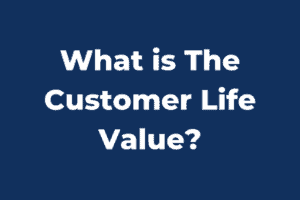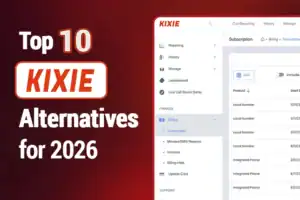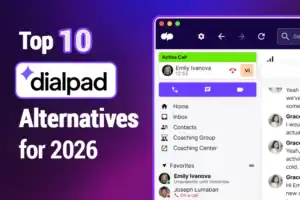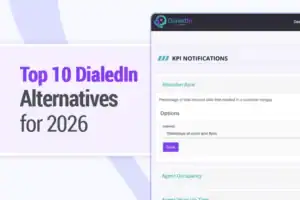Customer lifetime value is a metric used in business to assess how much money a company can expect to generate from a client over the duration of their whole interactions or “lifetime”. Customer lifetime value estimates can be complicated due to variations in product type, price, frequency of purchase, and total buy volume. The lifetime value of a client, however, is a number that can be calculated with ease with the right method.
CLV allows for more educated marketing and sales decisions, among other benefits. This article, we will explain the nature of CLV, its advantages for call centers and how to calculate & improve it.
Key Points:
- Customer lifetime value is a metric that calculates the total net gains created by your customers during their business interactions
- To calculate a Customer lifetime value various teams must work together and share their data.
- Focusing on CLV steers your call center in a data-driven path
- Training and automation are key to a successful CLV
What is the Customer Lifetime Value CLV?
CLV stands for Customer Lifetime Value. It is a metric that calculates the total net gains created by your customers during their business interactions with your call center. This amount deducts your sales, marketing, and customer service charges.
This key performance indicator represents the sum of a company’s earnings made during its connection with a customer, from the initial transaction until the end of the contact. As a result, Customer Lifetime Value is a logical statistic based on quantifiable customer data.
As you might expect, it is an estimate, but it will be exact enough to allow you to set your next budgets, strategies, and other strategic actions.
Why call centers should focus on the customer lifetime value?
- Customer Lifetime Value can help call centers find ways to sell more or different things to customers. By knowing how valuable a customer could be to the business, a call center can change its sales pitch to offer products or services that the customer is more likely to be interested in.
- You business can figure out how well their efforts to keep customers can work. Call centers can tell if their efforts to keep customers are paying off by keeping track of how CLV changes over time.
- Customer Lifetime Value let you set priorities and make better use of your resources. For instance, a call center may decide to spend more time and money on keeping high-value customers because they are likely to generate more income over time.
How do you calculate the CLV?
To calculate a company’s CLV, the various teams must work together and share their data. Indeed, multiple organizational divisions may be involved in acquiring and retaining a consumer: customer support, and even after-sales service.
It is also crucial to collect the following vital information:
- Customer lifetime: How many years or months has your consumer placed orders with you?
- Purchase frequency: How many times has the consumer purchased your services or products during his lifetime as a customer?
- The average basket: is the average value of the orders placed by the customer over his tenure with your firm.
Average basket = (Sales made with the same customer) / (number of orders placed by the customer).
After that, you can calculate your Customer Lifetime Value.
The information you have gathered and determined will allow you to do the following calculation:
CLV = (average basket) * (purchase frequency) * (customer lifetime).
In simpler, you now know how much money your organization makes from each consumer.
Important to remember: Each consumer is unique. If you’ve been in business for a while, you’ve probably observed this. Some clients will be financially unprofitable but extremely loyal in the long run, while others will be extremely profitable in the short term but not very loyal in the long run.
This is why it is recommended to determine the key segments; you may utilize the same calculations by establishing averages based on a customer’s life, average turnover, or average costs. However, they can also be classified depending on their demographic history, demographic profiles, or the type of industry your call center operates in.
Let us look at a basic example:
We have an internet provider who suggests typical monthly subscriptions of 50$.
- The frequency here is monthly (1×12), the subscription being renewed automatically.
- The customer in average his subscription 3 years. This is the life of the customer.
- The average basket is 50$, which is the price of the monthly subscription.
CLV = 50 $x 12 months x 3 years = 1800$.
What are the advantages of a Customer Lifetime Value for Call Centers?
Let’s take a look at the perks of customer lifetime value :
- Swiftly and correctly handle customer requests: With the support of Customer Lifetime Value, call centers can now quickly address all customer requests, even the most complex ones. Customers with a high CLV may be prioritized, and agents can work on a proactive basis to remedy their issues, ensuring that this segment is happy with the consistent and excellent service.
- Return on Investment: Accumulated CLV about the clients that provide you the most income might aid in the preparation of different business reports. With these data, you may compare client CLV to establish the optimal retention approach. This will aid in assessing your call center’s ROI and identifying the targets that agents should focus on.
- Focusing on CLV steers your call center in a data-driven path: which is far more sustainable. Investing in your consumers over time helps you to proactively improve their experience throughout their lifetime. Simply responding to questions on purchase frequency, nurturing, and retention can assist you in identifying more effective techniques.
How do you need to increase your call center CLV?
Customer Lifetime Value is a key performance indicator (KPI) for your company. It is consequently critical to improve it in order to ensure your company’s long-term prosperity. You have various complementary options for doing so.
1.Calculate your Customer Acquisition Cost (CAC)
This information, known as the CAC or Customer Acquisition Cost, will be critical in adjusting your activities and strategic decisions. It provides a link between the amount spent on marketing, sales, and other services to acquire a new client and the number of consumers gained. We recommend reading our essay on the issue, Customer Acquisition Cost.
CAC = Costs to acquire new customers
2.Establish a target Customer Acquisition Cost to Customer Lifetime Value ratio.
Your intended CAC/CLV ratio will be determined by your industry and whether you offer subscription-based products, services, or software solutions. Another factor that influences this ratio is the life cycle of your company.
Your CAC/CLV ratio is also affected by the phase in which your company operates. Yes, it is not simply your consumers that are important! If you are in the early stages of your business, you may be ready to spend more to gain your initial clients and have a lower ratio.
Finally, your production costs and desired margins will be important factors. You say it’s obvious. It certainly is! Now that you understand the importance of Customer Lifetime Value (CLV) and its evolution components, it is up to you to define a target ratio. It will enable you to calculate your Customer Acquisition Cost.
Your CAC must be lower than your CLV in order to be profitable.
Leverage the power of data with our Cloud Contact Center Solution! NobelBiz OMNI+ has personalized Reports Engine that gets your call center reliable data from a wide range of analytics and reporting tools that provide historical and real-time information you can customize to build comprehensive performance reports.
3.Train Your call center Agents
AI-powered speech analytics solution provides unbiased scorecards automatically, allowing you to objectively analyze customer experience and improve agent performance. Calls are automatically rated according on the success criteria you provide, allowing you to coach agents to achieve better results.
You must improve training materials throughout the call center. Coaching and retraining agents with speech analytics can significantly improve CX and, by extension, client lifetime value.
 Training at a call center shouldn’t happen only once, during onboarding, but rather constantly, via repetition and reinforcement. An organization’s internal environment is always changing, but that shouldn’t get in the way of effective knowledge transfer to frontline employees. The CEO of Proponisi, Michael Tamer, has this to say about the subject of “The Need for Ongoing, Consistent, Repetitive Call Center Training”.
Training at a call center shouldn’t happen only once, during onboarding, but rather constantly, via repetition and reinforcement. An organization’s internal environment is always changing, but that shouldn’t get in the way of effective knowledge transfer to frontline employees. The CEO of Proponisi, Michael Tamer, has this to say about the subject of “The Need for Ongoing, Consistent, Repetitive Call Center Training”.
4.Create a smart automation plan to cut costs
Automation is perfect for lowering expenses while increasing efficiency. Indeed, strategies and technologies save you from recurring and repetitive jobs that have little additional value. As a result, you can automate your efforts toward a less profitable objective for your organization while focusing the majority of your time and resources on the prospects that will bring you the greatest profit. To ensure future client loyalty, each important future consumer must be given special attention.
5.Identifying call center Pain Points
Customer service is one of the most important parts of growing a business. It lets you build trust with your customers, figure out what they need, and take the steps you need to take to meet all of their needs.
On the other hand, customer service is a reliable way for a company to keep track of how its operations are going and how productive its employees are in real time. Customer feedback is one of the most important things that helps a company reach its goals by making the necessary changes and improvements. And from that feedback you can figure out all your call center pain points.
6.Boost customer satisfaction to keep your top customers
Customer satisfaction is the bedrock upon which customer loyalty is built. Indeed, a buyer who is completely content, if not delighted, with your brand is less inclined to investigate or contact your competitors. As a result, your relationship will last longer and your true profits will grow.
According to a study done by PWC, 65% of your targets would become long-term customers of a brand if they can by provided a positive experience throughout the customer journey.
7.Organize and use consumer data effectively.
Customer data is the primary source of fuel for customer relationships. Most businesses already have a massive quantity of data. However, this data is frequently dispersed throughout the information system, poorly integrated, aggregated, “siloed,” and assembled. This is why transaction data is often underutilized.
It is frequently used on the periphery by activation technologies like CRM or Automation. You must combine customer data with product data to profile customers and tailor your marketing based on their activity. This enables you to provide content and offers that are more relevant to your consumers’ interests and preferences.
Conclusion: Customer Life time Value is key to customer experience
Customer lifetime value is simply one of several measures used to assess the customer experience. Aside from CLV, typical metrics include:
CSAT score: A customer satisfaction score (CSAT) is exactly what it sounds like – an assessment of how happy a client is with their experience. These ratings are often acquired at the end of a client encounter via surveys or questionnaires. Typically, questions ask respondents to rank their experience on a scale of least to greatest satisfaction.
Net Promoter Score (NPS) : This is a measure of customer loyalty that is often determined by a single-question survey. Traditionally, such question asks the consumer to assess how likely they are to suggest the firm to a friend. In doing so, they categorize responders as critics, passives, or promoters.
Customer Effort: Its goal is to figure out how hard a customer had to work to get where they were going. This is because it is thought that the less work a customer has to do, the happier he will be and the more likely he will be to keep coming back.

Abdelmounim Benharouga has always had a strong passion for writing and digital marketing. He started as a Digital Content Writer part of marketing department then moved to being Customer Success Manager for the African Region within the Nobelbiz team.






